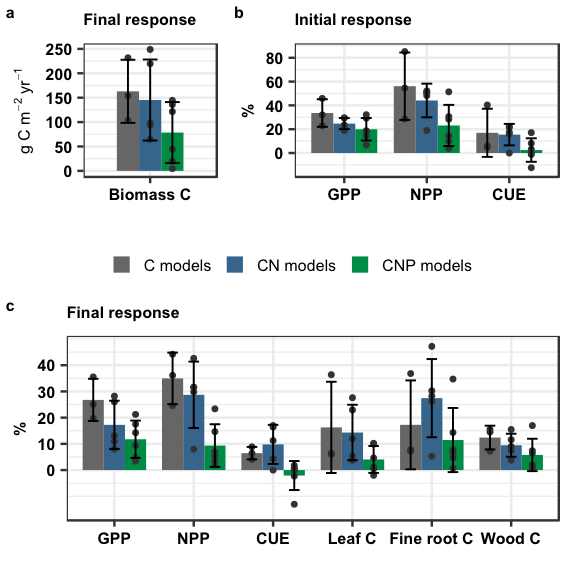Amazon forest response to CO2 fertilization

Amazon forest response to CO2 fertilization dependent on plant phosphorus acquisition
Background
The climate change with warmer temperatures and drier conditions pose a severe threat to the forests of the Amazon basin and is predicted to cause widespread forest dieback. One of the ways the Amazon forest regulates climate is through the cycling of carbon. This study examines the potential interactions between increasing atmospheric CO2 concentration and nutrient cycle feedbacks in mature Amazonian rainforests. Global models predict that the Amazon rainforest will act as a carbon sink due to rising atmospheric carbon dioxide concentration into the future. At the same time, soil phosphorus impoverishment in most of the Amazon basin is assumed to limit productivity and growth. Despite that, phosphorus feedbacks are not accounted for by global ecosystem model ensembles to date, e.g. in the Fifth Assessment Report of the United Nations Intergovernmental Panel on Climate Change and the ongoing sixth Coupled Model Intercomparison Project (CMIP6).
Science
The role of phosphorus availability has not been considered in any of the CMIP5 models. This study shows that phosphorus availability could greatly reduce the projected CO2-induced carbon sink in Amazon rainforests. This study suggests that the Amazon rainforest response to increasing atmospheric CO2 depends upon the ability of trees to upregulate phosphorus acquisition or phosphorus use efficiency in response to increased carbon availability.

Phosphorus limitation reduced the predicted biomass C sink by 52% and 46% compared to that in the C and CN models, respectively, with considerable variation within model groups. Final response is calculated as the mean response over 15 years of elevated CO2. Initial response is the first year response. GPP refers to Gross Primary Productivity, NPP is the Net Primary Productivity (which is GPP – plant respiration), and CUE is the carbon use efficiency and is defined as NPP/GPP.
Impact
Currently CMIP5 models predict that the Amazon rainforest will continue to act as carbon sinks in the future due to the CO2 fertilization effect. This study suggests that the CMIP5 predicted carbon sink would likely be much less due to phosphorus limitation, suggesting Amazon rainforests may be less resilient to climate change than previously assumed.
Summary
An ensemble of 14 terrestrial ecosystem models were used to simulate the planned free-air CO2 enrichment experiment AmazonFACE. Three of these models are variants of ELM, the land surface model of E3SM. They include the phosphorus enabled versions, ELMv1-CTC and ELMv1-ECA, as well as the carbon-only demographic and dynamic vegetation version, ELM-FATES. Ensemble model simulations showed that phosphorus availability reduced the projected CO2-induced carbon sink by about 50% compared to estimates from models assuming no phosphorus limitation. Large variations in ecosystem responses to elevated CO2 among P-enabled models are mainly due to contrasting representations of plant phosphorus use and acquisition strategies among models. This study highlights the importance of phosphorus acquisition and use, including alternative strategies, in Amazon rainforest responses to increasing atmospheric CO2 concentration.
Publication
Fleischer K, A. Rammig, M.G. De Kauwe, A. P. Walker, T.F. Domingues, L. Fuchslueger, S. Garcia, D. Goll, A. Grandis, M. Jiang, V.E. Haverd, F. Hofhansl, J. Holm, B. Kruijt, F. Leung, B. Medlyn, L.M. Mercado, R.J. Norby, B.C. Pak, B. Quesada, C. von Randow, K. Schaap, O. Valverde-Barrantes, Y. Wang, X. Yang, S. Zaehle, Q. Zhu, D. Lapola, 2019: Amazon forest responses to CO2 fertilization dependent on plant phosphorus acquisition, Nature Geoscience, https://doi.org/10.1038/s41561-019-0404-9.
Contact: Jeffrey Q. Chambers, Lawrence Berkeley National Lab
Funding: DE-AC02-05CH11231 as part of their Next Generation Ecosystem Experiment-Tropics (NGEE-Tropics) and Exascale Energy Earth System Model (E3SM) programs.


